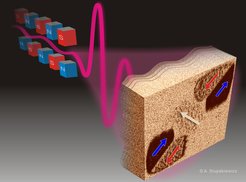Magnetization reversal by longitudinal lattice shaking
Previous attempts focused on resonant pumping of phonon modes failed. This study was made successful through the use of short and intense narrow-band infrared pulses from the free electron laser FELIX. It is ideally suited to fit the resonance frequencies of the lattice. Following the selective excitation nonlinear interactions in the phonon system change the potential landscape of the magnetic system, forcing the latter to evolve into a peculiar four-domain pattern, such as in yttrium iron garnet (YIG) films.

A thorough investigation of the phonon spectrum of YIG carried out by scientists from Stuttgart proved that the formation of the peculiar switching pattern is evidently caused by resonant pumping of specific excitations – longitudinal optical (LO) phonon modes – and not by heating via strongly absorbing transverse (TO) phonon modes. The measurements utilized synchrotron radiation to extend the frequency range of conventional spectroscopic ellipsometry by turning it into a powerful technique to study electrodynamics of thin films now reaching the terahertz range. The ellipsometer, developed in the Optical Spectroscopy group at MPI in Stuttgart, now operates routinely at the IR1 beamline of the Karlsruhe Research Accelerator (KARA) at the Karlsruhe Institute of Technology.
In the study, the team identified that the nonlinear phononic mechanism ensures that the strain pulse generated by the LO mode remains shorter than the magnetization precession period, which is required for switching. This is not the case with TO mode excitation, where the timescale is given by the heat dissipation processes. The researchers envisage that, through engineering of material parameters such as the magnetic anisotropy, magneto-elastic coefficients or crystallographic symmetries, alternative domain patterns can be realized with different spatially distributed magnetization states.
Alexander Boris











